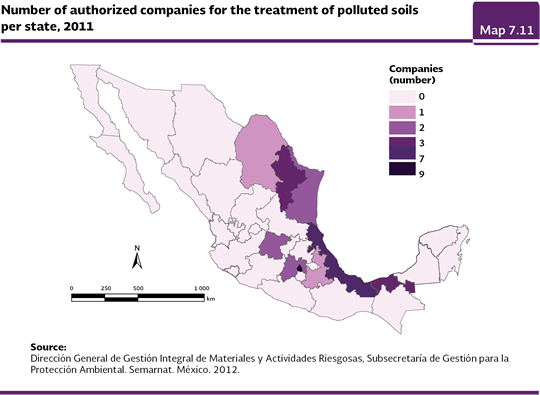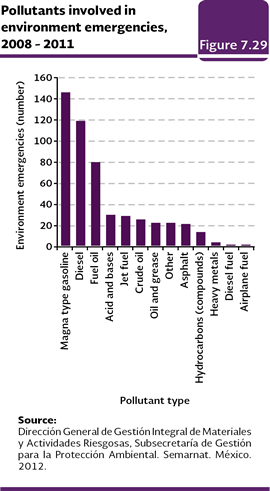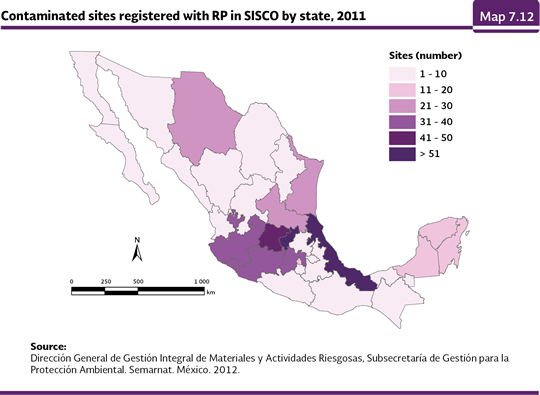
| CHAPTER 7. WASTE |
POLLUTED SITES The industrialization process occurred in the country during the last century without the existence, in its initial stages, of a specific regulation framework which regulated and monitor the handling and discharge of materials and hazardous waste left, as a result, the presence of polluted sites. The polluted sites may be defined as those places where three has been a deposit, burial or discharge of chemical substances or waste, related to industrial, commercial, agricultural or domestic activities. Among the principal reasons that may cause the pollution of a site are a) the inadequate disposal of RSU, RP and RME in vacant lots, warehouses, storing facilities, and industrial yards; b) material or RP leaks from tanks and ground containers pipes and ducts, as well as from sewerage and industrial and public drainage; c) material leaching in storing sites and either productive activities are carried out, or else, from sanitary fills and open air fills; d) accidental leaks of chemical substances during their transportation; e) application of chemical substances, potentially toxic in the soil, facilities and buildings; and f) the discharge of waste waters which contain RP and chemical substances potentially toxic without a previous treatment. It is competence of the federal government to regulate and control the generation, handling and final disposal of materials and HW, including specifically the responsibilities, procedures and conditions for the remediation of contaminated sites. When it is needed, the environmental remediation deals with the removal of pollution to a safe level for health and the environment or prevent its dispersion in the environment, allowing its use in accordance with the regulation of the use of soil and the programs of environmental management and development. It is responsibility of the federal government to regulate and control the generation, handling and final disposal of the materials and RP, including specifically, the responsibilities, procedures and conditions for the remedying of polluted sites. When it is necessary, the remedying has as the basic goal to eliminate or reduce the pollution up to a safe level for the health and the environment or to prevent its spread in the environment, allowing its use according to the regulation of land use and the programs of ecologic management and development. The Semarnat classifies the contaminated sites in two types: on one hand, the called environmental liabilities, of large dimensions and with remediation obligations, with problems caused by the industrial use of the soil and the inadequate handling of RP which were not remedied in time to prevent the pollutant spread. This category also includes the pollution generated by an emergency which has long-term effects on the environment. In second place, the polluted sites caused by environment emergencies (EA), whose attention is given when the site pollution is the result of a circumstance or event, undesired or unexpected, which suddenly happens and, as a result, there is a non-controlled release, fire or explosion of one or several materials or RP that affect the human health or the environment in and immediate way (Semarnat, 2011). In 2011, there were 30 companies authorized to treat the polluted soils in order to deal with the liabilities and the environment emergencies. At the state level the ones which had the largest number were Mexico City (with 9 companies), Veracruz (7) Tabasco and Nuevo León (with 3 each one; Map 7.11; Table D3_SITES01_01).
During 2008-2011 period, 514 sites polluted by environment emergencies were identified, whose responsible ones involved in a larger percentage were the shipping carriers 379 emergencies (73.6% of the recorded total), followed by Pemex with 100 (19.5%) and by railways (8; 1.6%; Figure 7.28; Semarnat 2011; Table D3_SITES02_02).
The pollutants involved in the environmental emergencies for this same period were in first place the hydrocarbons: magna type gasoline with 146 emergencies, followed by diesel with 119, fuel oil with 80, jet fuel with 29 and other pollutants such as acids and bases with 30 (Figure 7.29; Semarnat 2011; Table D3_SITES02_01).
Environment liabilities Semarnat performs various actions to deal with the environmental liabilities management, among which are the assessments of remedy programs of polluted sites, which attempt to determine the necessary actions to eliminate the negative impacts to the environment caused by the material and RP pollution. The remedy projects of polluted sites are carried out by itself or in collaboration with other such as state governments. In order to know and to record at the national level the polluted sites considered as environmental liabilities, Semarnat has implemented the Computer System of Polluted Sites (SISCO; Semarnat 2011). For the period 1995-2000, the SISCO had identified 166 recorded sites polluted with materials or RP; by 2011 there were 582 sites recorded. The system has been a valuable tool which has allowed identifying the polluted sites as well as establishing priorities depending on their risk, based on a preliminary environment risk assessment. By 2011, the states with the largest number of sites identified as polluted were Veracruz (69 sites), Querétaro (58), Guanajuato (48), State of Mexico (35), Michoacán (34) and Aguascalientes (31; Map 7.12; IB 5-3; Table D3_SITES03_01).
|



